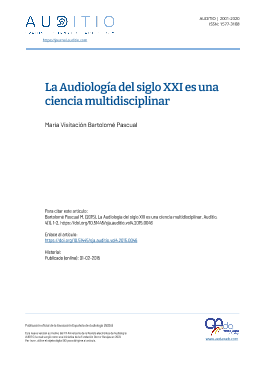21st century Audiology is a multidisciplinary science
DOI:
https://doi.org/10.51445/sja.auditio.vol4.2015.0046Keywords:
AudiologyAbstract
The creation of the term and concept of Audiology is attributed to different authors, Schier, Nowak, Canfield, Hargrave. In 1946, Carhart et al. Defined Audiology as the science that deals with hearing disorders in both normal and pathological ears. The term Audiology, even today, lacks a precise definition, it still does not have a reference in the dictionary of the Royal Academy of the Spanish Language, which reflects the complexity of this science to be able to reference it in a specific area of knowledge. Audiology is the branch of science that studies and analyzes the physiological processes that allow, through the mechanism of hearing, to interpret “what is heard”, being able to differentiate into “how and how much is heard”. This differentiation of how much and how it is heard makes Audiology a quantifiable science allowing to determine the degree of hearing loss, which facilitates intervention, treatment and prosthetic adaptation in order to replace and restore any hearing impairment. The progress of knowledge in Audiology like any other clinical branch of Health Sciences is based on basic research. The evolution of basic research in Audiology has not stopped progressing and contributing knowledge about the nature of the structural elements at the peripheral level and the central nervous system. The complex functioning of these structural elements not only related to the auditory process but also the close relationship of hearing with the interpretation of oral language, with other sensory organs such as sight, smell, balance, memory, are allowing that in this 21st century , Audiology has become a shared discipline, analyzed and used by different professionals, thus being a multidisciplinary science. The period between the years 1960-1970 where Audiology is mainly clinical and is defined as a branch of Otology, related to other clinical specialties of Health Sciences such as Phoniatrics, Geriatrics, Pediatrics, Neurology, Psychiatry . From the years 1980-2000, basic research in Audiology began with a great profusion of scientific publications where the different elements and structures that make up the cochlea are made known and how these structures have a close functional correlation with the transformation of the wave sound in a synaptic message. The cochlea (peripheral hearing), as well as the auditory pathway and cortex (central hearing) of all mammals, including humans, process the transformation of the auditory signal in a very similar way, which allows the generation of experimental models that allow analyzing the auditory pathologies that have occurred in the daily clinic. Advances in morphological, structural and functional knowledge of the ear and the auditory pathway have allowed the development of Electroacoustics and the construction of different systems and electronic equipment at the service of Audiology. The different types of electrophysiological recordings allow to identify, quantify and evaluate with greater precision the representation of the activity of the peripheral and central auditory system after applying a sound stimulus. At present, the corroboration of morphological results with audiological results allows to improve the precision of “how and how much is heard”. In humans, oral language makes Audiology reach a maximum range of complexity, since hearing and language are directly related. At the end of the 20th century, the advance in the knowledge of Psychology, Speech Therapy, Linguistics will allow Audiology to know and interpret quantitatively and qualitatively the auditory process from the peripheral receptor to the auditory cortex in a normal, deaf subject , hard of hearing, and hyperacusic. The Audiology of the XXI century is characterized by being a mandatory Multidisciplinary Science, since professionals and scholars from both branches of knowledge (Health Sciences and Social Sciences) are expanding the knowledge and relationship of hearing with other vital, sensory and functional functions. social aspects of the human being. This multidisciplinarity favors the binomial of basic and clinical research and will undoubtedly allow us to advance along different paths, which will undoubtedly converge in expanding knowledge in hearing and language. Despite the development in communication technologies, these will not be able to replace oral communication and therefore it is essential to offer the patient with hearing impairments or alterations an improvement in the recovery of lost hearing and the reinterpretation of sound regardless of what it is. deficiency has occurred in a pre-lingual or post-lingual period. This Journal ,"Audito", since it is an electronic journal, intends almost immediately to make public the results obtained, as well as exchange knowledge and projects with different professionals of the Spanish language who are interested in the process of “how and how much we hear”.
Downloads
Visibility and Altmetrics
Metrics
Global Statistics ℹ️
|
2506
Views
|
900
Downloads
|
|
3406
Total
|
|

Published
Versions
- 2021-09-15 (2)
- 2015-02-01 (1)
How to Cite
Issue
Section
License
Copyright (c) 2015 Asociación Española de Audiología

This work is licensed under a Creative Commons Attribution 3.0 Unported License.
All articles will be published under the open Creative Commons Attribution (CC-BY) license. This license allows others to share and adapt the content, even for commercial purposes, as long as appropriate credit is given to the authors and the journal. By submitting their manuscript, authors retain copyright but grant the journal the right to make the first publication under this license.
More information about this license is available at: https://creativecommons.org/licenses/by/4.0/
Articles published between 2001 and 2020
The texts published in this journal in the section "AUDITIO 2001-2020" are subject - unless otherwise indicated - to a Creative Commons Attribution 3.0 Spain license. You can copy, distribute, communicate them publicly, make derivative works and commercial uses provided that you acknowledge the credits of the works (authorship, name of the journal, publishing institution) in the manner specified by the authors or by the journal. The full license can be consulted at http://creativecommons.org/licenses/by/3.0/es/deed.es.









